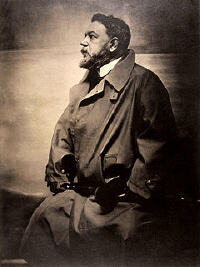
Joaquin Sorolla y Bastida was born in Valencia. As a student, he spent time in Rome and Paris. Soon, from 1890 to 1900, Sorolla's paintings were seen in all the leading European salons. He painted 500 works for his first one-man show at the Galeries Georges Petit in Paris in 1906, quickly followed by exhibitions in Berlin (1907), London (1908), New York (1909), Chicago, and St Louis (1909). His early works such as Sad Inheritance (1899; Valencia, Caja de Ahorros de Valencia) were influenced by the art of Jules Bastien-Lepage and Adolphe von Menzel as well as by the social realism championed by his friend the novelist Vicente Blasco Ibáñez. Although these paintings made him well known, Sorolla later found the subjects sentimental. Indeed, his reputation would rest instead with his renderings of Valencia's Mediterranean shore. Painting out of doors, Sorolla vividly captured the sparkling blues of the water and golden sunlight in works such as The Return from Fishing (1894; Paris, Musée d'Orsay). From 1911 to 1919 Sorolla worked on the immense depictions of the landscape, costumes, and popular traditions of the unique regions of Spain commissioned by Archer M.Huntington for the Hispanic Society of America in New York (in situ). Sorolla also had a successful career as a portraitist; his distinguished sitters included King Alfonso XIII of Spain (1907; Madrid, Palacio Real) and American President Taft (1909; Cincinnati, Taft Mus.).